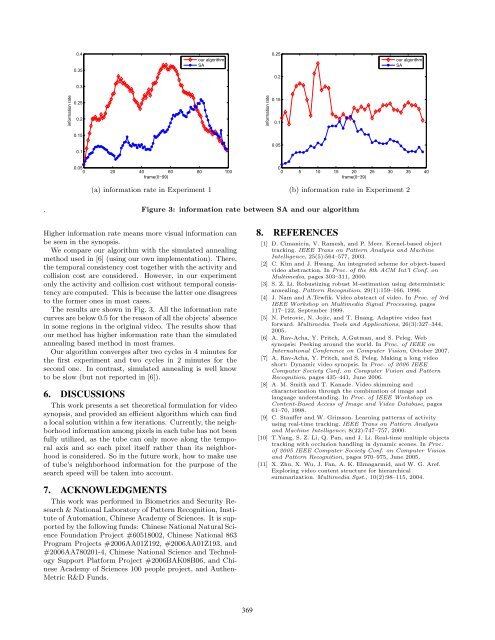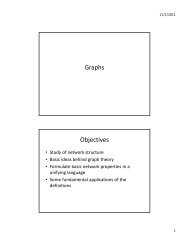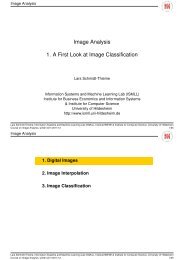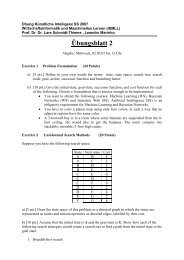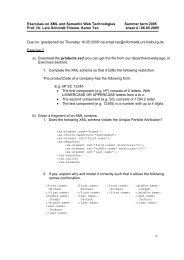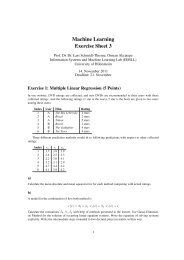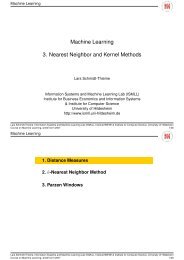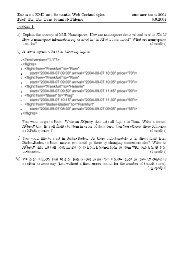A Set Theoretical Method for Video Synopsis - ACM Digital Library
A Set Theoretical Method for Video Synopsis - ACM Digital Library
A Set Theoretical Method for Video Synopsis - ACM Digital Library
You also want an ePaper? Increase the reach of your titles
YUMPU automatically turns print PDFs into web optimized ePapers that Google loves.
0.4<br />
0.35<br />
our algorithm<br />
SA<br />
0.25<br />
0.2<br />
our algorithm<br />
SA<br />
0.3<br />
in<strong>for</strong>mation rate<br />
0.25<br />
0.2<br />
in<strong>for</strong>mation rate<br />
0.15<br />
0.1<br />
0.15<br />
0.1<br />
0.05<br />
0.05<br />
0 20 40 60 80 100<br />
frame(0−99)<br />
(a) in<strong>for</strong>mation rate in Experiment 1<br />
0<br />
0 5 10 15 20 25 30 35 40<br />
frame(0−39)<br />
(b) in<strong>for</strong>mation rate in Experiment 2<br />
.<br />
Figure 3: in<strong>for</strong>mation rate between SA and our algorithm<br />
Higher in<strong>for</strong>mation rate means more visual in<strong>for</strong>mation can<br />
be seen in the synopsis.<br />
We compare our algorithm with the simulated annealing<br />
method used in [6] (using our own implementation). There,<br />
the temporal consistency cost together with the activity and<br />
collision cost are considered. However, in our experiment<br />
only the activity and collision cost without temporal consistency<br />
are computed. This is because the latter one disagrees<br />
to the <strong>for</strong>mer ones in most cases.<br />
The results are shown in Fig. 3. All the in<strong>for</strong>mation rate<br />
curves are below 0.5 <strong>for</strong> the reason of all the objects’ absence<br />
in some regions in the original video. The results show that<br />
our method has higher in<strong>for</strong>mation rate than the simulated<br />
annealing based method in most frames.<br />
Our algorithm converges after two cycles in 4 minutes <strong>for</strong><br />
the first experiment and two cycles in 2 minutes <strong>for</strong> the<br />
second one. In contrast, simulated annealing is well know<br />
to be slow (but not reported in [6]).<br />
6. DISCUSSIONS<br />
This work presents a set theoretical <strong>for</strong>mulation <strong>for</strong> video<br />
synopsis, and provided an efficient algorithm which can find<br />
a local solution within a few iterations. Currently, the neighborhood<br />
in<strong>for</strong>mation among pixels in each tube has not been<br />
fully utilized, as the tube can only move along the temporal<br />
axis and so each pixel itself rather than its neighborhood<br />
is considered. So in the future work, how to make use<br />
of tube’s neighborhood in<strong>for</strong>mation <strong>for</strong> the purpose of the<br />
search speed will be taken into account.<br />
7. ACKNOWLEDGMENTS<br />
This work was per<strong>for</strong>med in Biometrics and Security Research<br />
& National Laboratory of Pattern Recognition, Institute<br />
of Automation, Chinese Academy of Sciences. It is supported<br />
by the following funds: Chinese National Natural Science<br />
Foundation Project #60518002, Chinese National 863<br />
Program Projects #2006AA01Z192, #2006AA01Z193, and<br />
#2006AA780201-4, Chinese National Science and Technology<br />
Support Plat<strong>for</strong>m Project #2006BAK08B06, and Chinese<br />
Academy of Sciences 100 people project, and Authen-<br />
Metric R&D Funds.<br />
8. REFERENCES<br />
[1] D. Cimaniciu, V. Ramesh, and P. Meer. Kernel-based object<br />
tracking. IEEE Trans on Pattern Analysis and Machine<br />
Intelligence, 25(5):564–577, 2003.<br />
[2] C. Kim and J. Hwang. An integrated scheme <strong>for</strong> object-based<br />
video abstraction. In Proc. of the 8th <strong>ACM</strong> Int’l Conf. on<br />
Multimedia, pages 303–311, 2000.<br />
[3] S. Z. Li. Robustizing robust M-estimation using deterministic<br />
annealing. Pattern Recognition, 29(1):159–166, 1996.<br />
[4] J. Nam and A.Tewfik. <strong>Video</strong> abstract of video. In Proc. of 3rd<br />
IEEE Workshop on Multimedia Signal Processing, pages<br />
117–122, September 1999.<br />
[5] N. Petrovic, N. Jojic, and T. Huang. Adaptive video fast<br />
<strong>for</strong>ward. Multimedia Tools and Applications, 26(3):327–344,<br />
2005.<br />
[6] A. Rav-Acha, Y. Pritch, A.Gutman, and S. Peleg. Web<br />
synopsis: Peeking around the world. In Proc. of IEEE on<br />
International Conference on Computer Vision, October 2007.<br />
[7] A. Rav-Acha, Y. Pritch, and S. Peleg. Making a long video<br />
short: Dynamic video synopsis. In Proc. of 2006 IEEE<br />
Computer Society Conf. on Computer Vision and Pattern<br />
Recognition, pages 435–441, June 2006.<br />
[8] A. M. Smith and T. Kanade. <strong>Video</strong> skimming and<br />
characterization through the combination of image and<br />
language understanding. In Proc. of IEEE Workshop on<br />
Content-Based Access of Image and <strong>Video</strong> Database, pages<br />
61–70, 1998.<br />
[9] C. Stauffer and W. Grimson. Learning patterns of activity<br />
using real-time tracking. IEEE Trans on Pattern Analysis<br />
and Machine Intelligence, 8(22):747–757, 2000.<br />
[10] T.Yang, S. Z. Li, Q. Pan, and J. Li. Real-time multiple objects<br />
tracking with occlusion handling in dynamic scenes. In Proc.<br />
of 2005 IEEE Computer Society Conf. on Computer Vision<br />
and Pattern Recognition, pages 970–975, June 2005.<br />
[11] X. Zhu, X. Wu, J. Fan, A. K. Elmagarmid, and W. G. Aref.<br />
Exploring video content structure <strong>for</strong> hierarchical<br />
summarization. Multimedia Syst., 10(2):98–115, 2004.<br />
369


